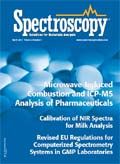Keep Your Distance
The growing and evolving use of homemade explosives, as well as biological and chemical threats, in terrorism and modern warfare, has driven the development of new and improved methods for detecting and identifying these materials. University and military researchers, as well as commercial instrument companies, are working hard to develop systems that are portable and rugged enough for field use, particularly for standoff detection.
The growing and evolving use of homemade explosives, as well as biological and chemical threats, in terrorism and modern warfare, has driven the development of new and improved methods for detecting and identifying these materials. University and military researchers, as well as commercial instrument companies, are working hard to develop systems that are portable and rugged enough for field use, particularly for standoff detection. Indeed, at the Pittsburgh Conference last month, quite a few sessions focused on remote detection, and four out of six articles in our April Defense and Homeland Security supplement (www.spectroscopyonline.com/defense2011), discuss advances in such methods.
Anupam Misra and Shiv Sharma of the University of Hawaii, for example, have demonstrated standoff Raman detection of chemicals used in the synthesis of homemade explosives at 10 m using single-pulse excitation with a 5-in. telescopic system, and now have developed an 8-in. telescopic system that can detect those materials at 120 m.
One concern with Raman analyzers, however, is eye safety. Stuart Farquharson and his colleagues at Real-Time Analyzers (Middletown, Connecticut) have compared laser excitation at various wavelengths for detecting two explosives, TNT and RDX. Although 1064-nm excitation provides the best quality spectra, the explosives could be detected with a laser using the excitation wavelength of 1550 nm, which poses less risk to the retina and also reduces fluorescence interference. Signal intensities are 5–10 times lower at 1550 nm, however, and there is increased noise. Nonetheless, they believe it is possible to use this wavelength to identify explosives if high laser powers or long acquisition times are acceptable.
At Pittcon, Andrzej Miziolek of the United States Army Research Laboratory discussed the potential of laser-induced breakdown spectroscopy (LIBS) for field forensics. He pointed out that conventional nanosecond LIBS has been demonstrated for standoff detection of residue explosives at 50 m, and chemical and biological residues at 20 m. No sample preparation is required, and the method has high sensitivity at residue levels and high specificity (typically >95% true positives and <5% false positives, when using advanced chemometrics). Also, LIBS is capable of elemental fingerprinting, can detect a wide range of hazardous materials, and works on various states of materials, including solid residues, liquids, aerosols, and vapors. His laboratory just purchased a new commercial system and soon will begin field testing it.
Alan Ford of Alakai Defense Systems (Largo, Florida) has been working with colleagues at the United States Army Research Laboratory (ARL) and Edgewood Chemical and Biological Center on the development of a system to detect trace explosives that combines LIBS with Raman. They enhanced LIBS signals with Townsend-effect plasma spectroscopy (TEPS) to extend the standoff distance and sensitivity. They then put the TEPS-LIBS and multiwavelength Raman systems in a single instrument that shares a UV laser. An advantage of the combination is that the two methods are orthogonal.
Samuel Hernandez and his colleagues at the University of Puerto Rico, in turn, see a bright future for the use of quantum cascade laser (QCL) excitation for standoff mid-infrared detection of highly energetic materials. Advances are still needed in the tuning ranges for these systems, but these researchers believe that developments in QCL applications will enable the design of spectrometers that cover the 3–12 μm spectral range at >100-m standoff distances. Christopher Kendziora and colleagues at the Naval Research Laboratory are also exploring QCL-based thermal imaging techniques for standoff explosives detection.
It's encouraging to see the intensity of focus on developing these methods and instruments. They will be critical for allowing those who defend us to keep their distance from harm.

Laura Bush Laura Bush is the editorial director of LCGC North America and Spectroscopy, lbush@advanstar.com.


Newsletter
Get essential updates on the latest spectroscopy technologies, regulatory standards, and best practices—subscribe today to Spectroscopy.
The Rising Role of Near-Infrared Spectroscopy in Biofuel Innovation
July 25th 2025A new bibliometric study published in Infrared Physics & Technology highlights the growing global impact of near-infrared (NIR) spectroscopy in biofuel research, revealing key trends, contributors, and future directions for advancing sustainable energy solutions.
Best of the Week: The Emerging Leader in Molecular Spectroscopy, Big Pharma’s Manufacturing Shift
July 25th 2025Top articles published this week include a feature article about big pharma’s investments in U.S.-based manufacturing, an article about the 2025 Emerging Leader in Molecular Spectroscopy Lingyan Shi, and some news items detailing the winners of the Coblentz Society’s student awards.